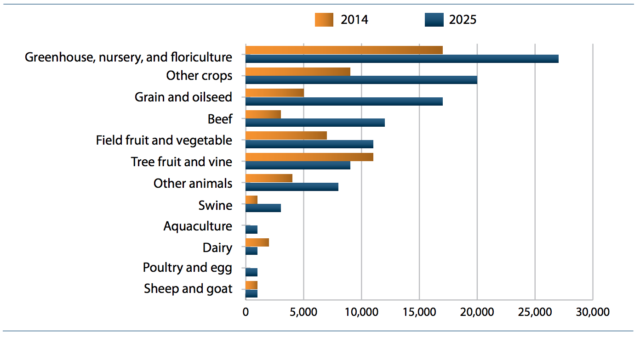The horticultural industry has been plagued with a major challenge; how to fill the increasing number of vacant positions within the commercial horticulture industry and, ultimately, reduce the age gap that currently exists within the industry. As consequence of increasing production targets and a shrinking domestic workforce, shortages in domestic labour are expected to intensify over time with notable impact on the horticultural sector. A report published by the Canadian Agricultural Human Resource Council (CAHRC) predicts a surplus of 114,000 vacant agricultural jobs, a quarter of which are anticipated to be from the greenhouse, nursery and floriculture sector, by 2025. In 2014 alone, vacancy of 5,800 domestic positions cost the horticulture industry a staggering $353 million in lost sales. Inspiring the next generation of horticulturalists is an important ‘next step’ as the industry moves forward.

Though it would be wrong of me to reduce the reasons for this domestic labour shortfall to a single event, one factor did stand out; the lack of awareness towards, and negative public perception of the horticultural industry. As a member of the Generation Y, or millennial, cohort (those born between 1977 and 1995), I relate to the lack of awareness towards the diversity of jobs within the horticultural, and broader agricultural industries. In fact, throughout my post-secondary education and at the start of my career, I hadn’t considered exploring opportunities related to horticulture. It wasn’t until I had come across my current position on LinkedIn (link to PL LinkedIn page) that I became aware of the number of benefits associated with the industry. For me, these benefits included the ability to work in a ‘growing’ industry (see what I did there) for a company committed to being at the fore-front of innovation in the grow lighting sector.
Tips to attract and retain the next generation
This leads me to my first piece of advice for organizations looking to recruit young personnel, meet them where they already are. Using social media as a recruiting tool, especially LinkedIn, which is most popular among 25 to 29-year old’s, is essential. Organizations should also use social media to tell stories about their brand and capture aspects of their company culture. Company culture has been identified as being important to millennials, and so featuring content that centres around aspects such as the opportunity for professional development or teamwork is an important strategy to consider when recruiting young personnel.
In fact, one of the factors that excited me about P.L. Light Systems was that, through social media and in speaking with management, I was able to gather that the company valued teamwork among employees. Entering this industry with no previous experience in horticulture or supplemental lighting, I was thrilled to learn that P.L. Light Systems encouraged collaboration and the opportunity to learn from the expertise of co-workers. I’m not alone in my admiration for teamwork, as 60% of millennials report a preference for working in face-to-face groups. Emphasizing the level of teamwork within company culture is also likely to improve employee retention rates, as, in my experience, it’s much harder to leave a career once workplace friendships are formed.
“more than 70% of millennials reporting that Canada should be doing more to address climate change, this issue can be viewed as an opportunity to motivate young people…”
Another factor to consider is that many millennials are looking to make a difference through meaningful work and emotional rewards. Many young professionals are looking to feel good about their work and the impact it has on broader society. Highlighting the ways in which horticulture impacts environmental and social issues is likely to inspire young people to want to work in the industry. In my experience, studying the various projects that P.L. Light Systems was involved in excited me towards the meaningful impact my career would have on customers tackling issues such as climate change and sustainable food production. With more than 70% of millennials reporting that Canada should be doing more to address climate change, this issue can be viewed as an opportunity to motivate young people to pursue careers in horticulture.
Finally, many young people may be unaware of the diversity in career paths that exists within the horticultural industry. Increasing the level of awareness towards the broad array of careers, which range anywhere from sales and marketing to engineering and research, early in one’s education. With the recent announcement of Canada’s Agricultural Youth Green Jobs Initiative investment in Ontario’s Greenbelt Microgreens, I believe government and industry partnerships are crucial for recruitment. Such investments directly impact young people’s opportunities for experience and thus advancement within the industry.
Written by – Jacqueline Anderson is a Digital Marketing Specialist with P.L. Light Systems, having joined the team in the Summer of 2018. Jacqueline’s passion for storytelling and knack for social media allows her to engage with current and prospective customers online.



